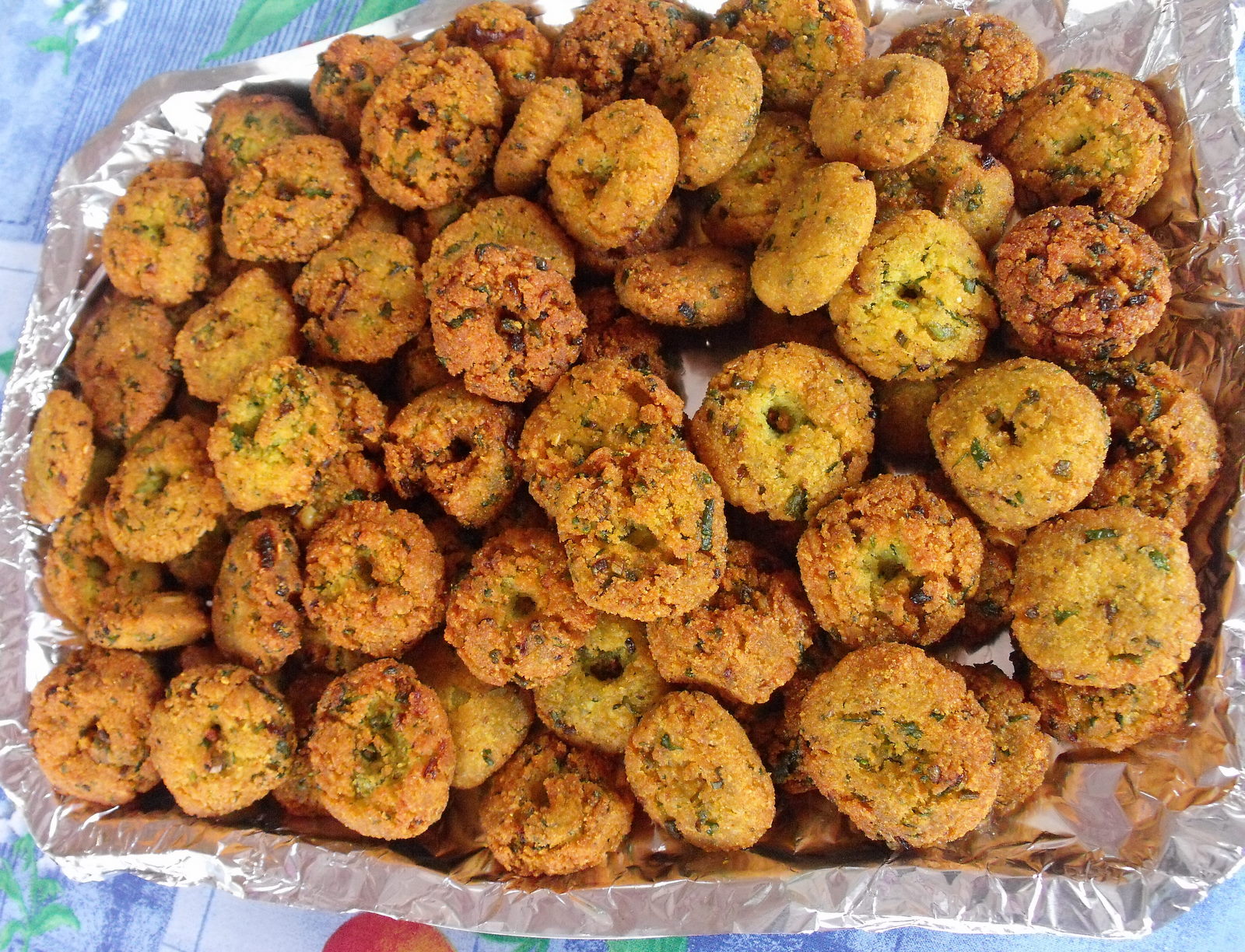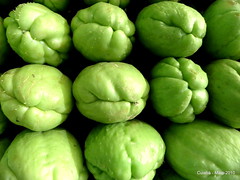Here's a (non-exhaustive!) list of some words and terms that will be helpful to you if you visit
Reunion Island. Some are
Reunion Creole words, others are French words with a different meaning from that in mainland France, and some are straightforward French but with a particularly local meaning. Many of the Creole words in this list are widely used in Reunion even in spoken French. This little glossary has no intention of replacing a dictionary or phrase-book however - there are other resources for that.
Note that Reunion Creole has no fixed spelling, so written variations are possible. (All further references to Creole here suppose Reunion Creole).
- achard - picked vegetable salad, rather like a spicy coleslaw but without the mayonnaise.
- alizé - trade winds from the south-east.
- baba figue/baba-fig - blossom of the banana tree, which is chopped with boucané (smoked pork) and made into a carri.
 |
| a baba figue in my garden |
- bichique/bishik - the fry of red-tailed goby (Sicyopterus lagocephalus) or Cotylopus acutipinnis which, at certain times of the year, are captured at river mouths as they swim upstream. They are caught using traditional techniques such as trap nets known as vouves. The bichique are then sold for about €45/kg to be made into a carri.
- bonbon piment - small savoury treats made from finely ground lentils or lima beans mixed with spices (piment).

- Bonbons piment
- boug - man.
- Bourbon - former name for Reunion Island 1649-1793 and 1810-1848; sometimes still used by companies as part of their trade name.
- brède - the leafy greens of various vegetables (there are ≈30 varieties) that are cooked and served with rice and carri, or made into a broth.
- cabri - an old French word for a kid; in Réunion the term covers all kinds of goats.
- cafre/kaf - a black Creole (feminine: cafrine/kafrine).
- cagnard - in the South of France this means a place where the sun beats down; in Réunion it means a thug or a delinquent.
- camaron - large freshwater shrimps, eaten in a carri.
- canal bichique - literally this is a channel of stones that's been built to help fish bichique, but it now has a second meaning. When the Route du Littoral (coast road between St Denis and La Possession) has to be reduced to three lanes (instead of the normal four) after heavy rain, the resulting narrow roadway is unofficially known as the canal bichique.
- carri/cari - general name for Réunion's national dish, normally consisting of meat or fish cooked with onions, garlic, turmeric (safran), thyme, salt, pepper and sometimes tomatoes. Normally served with white rice, rougail, lentils and occasionally brèdes.
- case/kaz - house.
- Cilaos - this is one of Réunion's cirques, but it has also given its name to a good brand of sparkling water, bottled in the cirque. If you want to order locally bottled still water ask for 'Australine' or 'Edena'.
- chouchou - a green, pear-shaped vegetable, known variously as christophine, chayote or choko in other parts of the world. Its green leaves can be used as brèdes.
- combava - a small, round, dark green citrus fruit with a rough, bumpy skin, known as kaffir lime (Citrus hystrix) in English. Its rind is used in Reunionese cuisine and has a very distinctive taste.
- cyclone - 'hurricanes', 'typhoons' and 'cyclones' are all different words for the same thing. As Réunion is in the southern hemisphere the official cyclone season runs from November 15th-April 15th, although out-of-season cyclones are occasionally possible. Reunion has a Regional Specialised Meteorological Centre, one of only six in the world, which keeps a close eye on things. Cyclone names are given by Mauritius or Madagascar.
- dalon - friend.
- dodo - unofficial, but widely-used name for a popular locally-brewed beer.
- faham - an orchid (jumellea fragans), increasingly rare and endemic to the Mascarene islands, that is used in rhum arrangé and some medicinal herbal teas (tisanes).
- fanjan - literally a tree fern, but more often used to refer to the mass of entangled tree fern roots that can be cut and used as a natural plant pot.

- Fanjan
- fénoir - darkness, night. When the Pope came to Réunion in 1989 he said "sort dann fénoir" ('Don't stay in the darkness').
- fet kaf - abolition of slavery which is celebrated every year by a public holiday on December 20th (20 desamb).
- filao - casuarina tree.
- Gabier - Guichet Automatique de Banque = ATM.
- gato - a sweet, confectionery. In Creole gato doesn't have the wider French meaning of 'cake'.
- goyavier - strawberry guava (Psidium cattleyanum), much-appreciated small red fruit that are ripe in May-July, and which grow in the highlands up to 1200m altitude.

- Goyavier
- grains - the beans or lentils in sauce that traditionally accompany a carri.
- gramoun - old person.
- Grande Ile - Madagascar, the 'Big Island'.
- guetali - a small gazebo-like structure typical of 19th century Creole architecture which could be found at the corner of the garden walls of large houses. From it the women of the household could watch people passing in the street without being noticed by them. Guetali are covered by a roof, and were often decorated with lambrequin. The name comes from "guette a li", which means 'watch him' in Creole.

- Guetali, Hellbourg, Salazie cirque
- (les) hauts - the highlands of Réunion; places that are not on the coast.
- Ile soeur - Mauritius (together with Rodrigues the three islands form the Mascarene Islands).
- îlet- a hamlet, particularly in one of the three cirques. (The final 'T' is pronounced).
- kabar - a more or less impromptu concert, with local music, dancing, singing and sometimes moringue.
- la-di-la-fé - gossip; also the name given to the machine that moves the concrete barriers on the Route du Littoral to make it into a canal bichique.
- lambrequin/lanbrokin - useful and ornamental patterned window and door borders made out of metal or wood. Design themes often reflect plant life. Originally a feature of naval architecture, they were used in Reunion to deflect and channel rain water at a time when gutters did not yet exist. Known in Creole as dantèl-lakaz - literally 'house lace' (see pictures here).

- Lambrequin
- letchis & mangues - lychees and mangoes are a national obsession from November to January when they are ripe. Prices start high but quickly come down as more and more fruit becomes available.
- lontan - in the past.
- macatia - a small slightly sweet bun, typical of Réunion.
- malbar - a Creole of Tamil origin.
- maloya - a traditional musical genre of Reunion, which has its origins in slaves' music. Songs are sometimes politically oriented, and themes are often slavery and poverty. The most well-known maloya artists are Danyel Waro, Ziskakan, Baster or Firmin Viry. In 2009 Maloya was inscribed on the Representative List of the Intangible Cultural Heritage of Humanity of UNESCO for France.
- marmaille/marmay - children.
- marron - a slave who escaped from their owner. By extension has come to refer to things that have gone wild or are illegal or 'underground'.
- massalé - an Indian spice mix commonly used in cooking (chili, coriander, cinnamon, cloves, fennel seeds).
- métropole - mainland France; the part of France in Europe. Don't forget that in Réunion you are already in France!
- moringue - a local, highly codified combat sport similar to Capoeira .
- paille en queue/payankë - white-tailed tropicbird (Phaeton lepturus) or occasionally red-tailed tropicbird (Phaethon rubricauda), easily identified by its long tail feathers.
 |
| Red-tailed tropicbird (photo by Laure Dherbécourt) |
- papang - Reunion Harrier (Circus maillardi) is the last and only bird of prey on Réunion.
|
|
| Drawing of a female Réunion Harrier (Circus maillardi) (Wikipedia) |
- peï - anything that is local.
- pistash - peanuts (not pistachios!).
- radier - a masonry structure in a road, built over the low point of a river, enabling the waterway to be crossed except during a period of heavy rain. (Never ever cross a radier when there's been heavy rain!).
- rhum arrangé - literally means 'arranged rum' but is better translated by 'macerated flavoured rum'. One or several ingredients such as vanilla, bananas, cinnamon, geranium, lychees, ginger or faham are added to a bottle of white rum and left to macerate for several weeks or months (the actual length of time depends on the ingredient(s)). It's mostly drunk as an after-dinner drink.

- Shelf of 'rhum arrangé'
- rougail - two meanings: (1) a cooked, main dish similar to a carri, generally with sausages, smoked pork (boucané) or dried, salted codfish (morue); (2) a spicy condiment similar to a chutney which accompanies every main meal in Réunion, composed of diced or crushed raw ingredients: ginger, chilli peppers, salt, onions and a main ingredient - most often tomato, but can be lemon or green mango.
- safran - not to be confused with saffron, this is the local name for turmeric, which is mainly grown at La Plaine des Grègues in the south of Réunion.
- samousa - triangular-shaped and similar to Indian samosas, local samousa are generally small with a spicy meat, fish or vegetable filling.
- séga - a traditional music genre from the Mascarene islands, with an associated dance form. It originated among slave populations, and is danced without the feet ever leaving the ground.
- St Expedit - a Roman soldier saint who is particularly venerated on Réunion. There are about 340 Saint Expeditus shrines in 263 locations around Réunion, often found by roadsides.

- St Expedit shrine, Entre-Deux
- tang - tenrec (Tenrec ecaudatus), a mammal which looks rather like a hedgehog, with a long pointed snout. It can be hunted from February to April, and can be eaten in a carri.
- ti'jaque - jackfruit (Artocarpus heterophyllus), a very large green fruit with an uneven skin. In Reunion it is finely chopped and cooked with smoked bacon to make the dish ti'jaque boucané.
- vacoas - the pandanus or screwpine tree, which can be found on the coast (Pandanus utilis) or in the highlands (Pandanus montanus). It produces an edible fruit called a pinpin, and its leaves can be woven to make objects such as a bertèl, a flat bag worn on the back.
|
|
| Pandanus montanus with pinpin fruit ( Wikipedia) |


















No comments:
Post a Comment